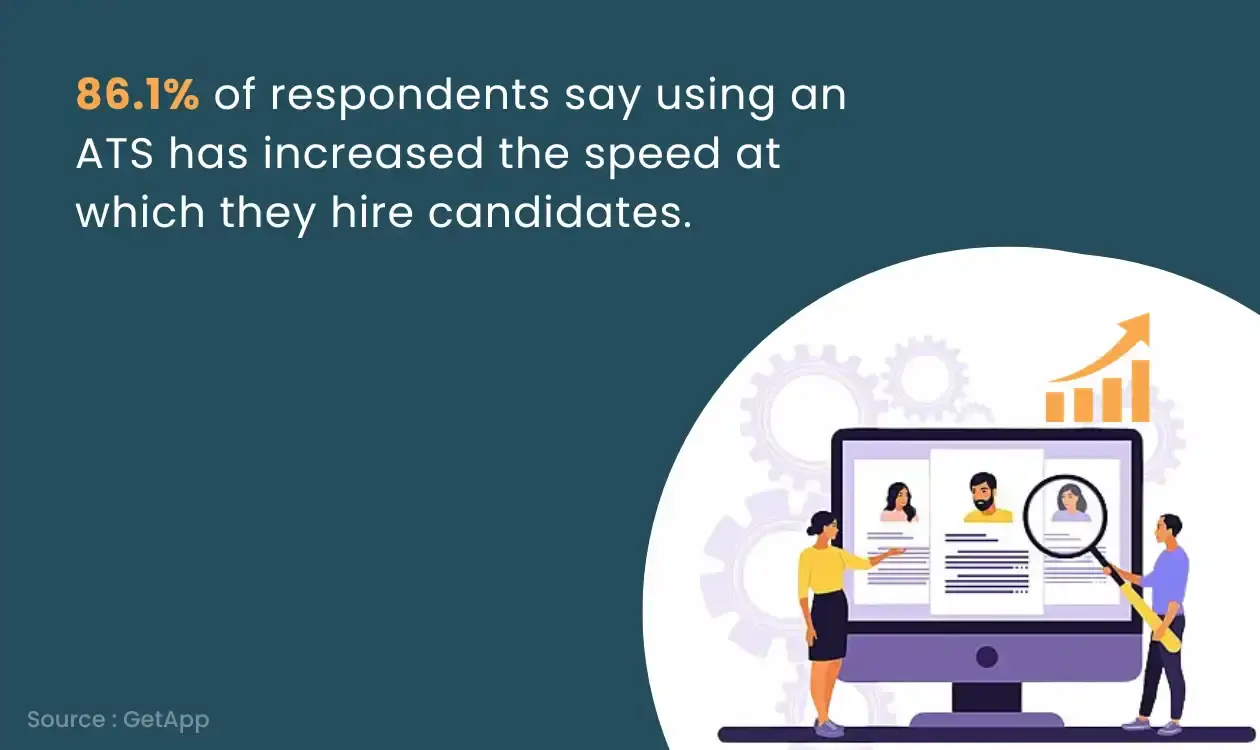The current job market is candidate-centric and highly competitive. Also, the recruitment landscape is constantly evolving. To remain competitive in this ever-growing economy, recruiters and HRs have to implement unique recruitment strategies to manage the workflow effectively, provide a positive candidate experience and hire top talent faster.
This is where recruitment strategy comes into the picture. A recruitment strategy enables hiring professionals to hire smarter. So, are you one of those recruiters, hiring managers or HR who want help creating a solid recruitment strategy to elevate your hiring efforts? If so, then explore this guide, where we narrow down practical recruitment strategies that will definitely work for you.
Let’s get started.
What is a Recruitment Strategy?
The recruitment strategy is a dedicated plan or approach companies develop to find, attract and hire top-level candidates for all open roles. Basically, it states the techniques organisations will implement to recruit the best people and provide them with a positive hiring experience.
In order to create a successful recruitment strategy, it is important that you are clear with your company's long-term goals, utilise various hiring techniques, keep an eye on the results and then refine the strategy that particularly works best for you.
Recruiters need to constantly evaluate recruitment strategy by taking feedback from candidates and hiring managers and refining it for optimal performance. Also, it needs to be adaptable to changing circumstances and future market conditions.
But wait, why do recruiters and HRs need a hiring strategy in the first place? Let’s understand that.
Why do You Need a Recruitment Strategy?
One thing is crystal clear: the recruitment process is a crucial component for any organisation. The talent you hire will determine the growth of your company. Hence, it is important to work on a recruitment strategy that enables you to attract and hire the best ones.
Here are some of the reasons why recruiters need a foolproof recruitment strategy.
- It streamlines the end-to-end recruitment.
- Recruiters can make sure that the process aligns with the future goals and objectives of the company.
- A structured hiring approach will ensure a fair process.
- Reduce time-to-fill open roles.
- Helps to hire cultural-fit candidates.
- A well-developed recruitment strategy helps to gain a competitive advantage in the job market.
- The hiring strategy focuses on nurturing relationships with potential candidates.
- It creates an attractive and positive employer brand image.
- It increases the effectiveness of your recruitment efforts.
- Better allocation to recruitment budget reduces cost-per-hire.
This way, the talent acquisition strategy is a powerful tool for recruiters to hire talent efficiently and cost-effectively.
Let’s now explore the best recruitment strategies to make your recruitment in 2025 a successful hit.
Top 12 Proven Recruitment Strategies for Successful 2025
1. Establish a strong employer brand
Creating a positive image of your employer is important to attract more candidates when the job is open within the organisation.
Post happy testimonials on the website and social media platforms. Make your employees your brand ambassador by creating employee advocacy initiatives.
In addition, share videos of offices, team outings, and daily life at your organisation. This way, you can sense the healthy work culture you have at your company. You can be creative and establish employee wellness professional development programs. All of these efforts will make you an attractive employer brand and help you attract a wider pool of talented candidates.
2. Create a compelling career website
The career page needs to have easy navigation so potential candidates can find all the essential information.
Highlight all the key benefits and perks candidates will get if they join your company. You can also add FAQs to solve common doubts candidates might have related to your hiring procedure and work culture.
Make your career page engaging by adding appealing visuals to grab candidates’ attention.
You can also integrate your career page with a recruitment chatbot tool to give responses to some of the standard questions candidates have. You can encourage candidates to apply for the various open positions via chatbot and let them know the status of their application.
3. Prepare a simple and clear job description
Your job description must be detailed and mention all the key responsibilities, qualifications, and skills. Don’t use jargon in your job description; keep the language simple and effective. It needs to stand out to attract more candidates.
You can include compensation and benefits candidates will get if they decide to join the organisation. Mention salary to attract more candidates as one survey by SHRM found that 70% of working professionals want to know about salary in the first message from a recruiter. Hence, mentioning the remuneration range in the job description is always a good idea.
A good example of excellent consistency in creating compelling job descriptions is Zapier. In their job description, they will always add their culture and values, code of conduct, and diversity and inclusion initiatives to showcase to candidates what the company is all about.
4. Invest in an Applicant Tracking System
It is always a better idea to utilise recruitment technology to streamline and automate the recruitment process. Recruitment software such as Applicant Tracking System (ATS) will help recruiters and HRs manage their recruitment workflow and candidate management, which enables them to provide a good candidate experience.
It also helps to reduce the hiring time and cost and make the overall process efficient. It simplifies managing candidate data and communication with candidates and helps in effective talent pool management.
5. Utilise social media recruitment best practices
4.48 billion people (56.8%) are using social media platforms As a result, social media is become an effective tool for recruiters to find and recruit top candidates. According to Muse, 42% of companies say the quality of talent has enhanced since they started using social recruiting practices.
Recruiters can use social media to the fullest to highlight positive company culture, join relevant community groups, and share value-adding content to attract candidates.
Organisations can create separate dedicated pages on social media for recruitment purposes. Also, they can be a bit innovative and come up with creative hashtags like Zappose created their own hashtags, which is known as “#insidezappos.” The company uses this hashtag to promote opportunities with its audience.
6. Focus on improving the positive candidate experience
Recruiters and HRs need to focus on clear and transparent communication with the candidates. They need to ensure that candidates go through a favourable and engaging hiring journey. As a result, the job acceptance ratio will increase, and candidates will talk positively about the organisation.
Here are some of the tips to enhance candidate experience throughout the hiring process.
-
Focus on clear communication to build trust.
-
Make the application process easy and user-friendly.
-
Give candidates timely updates on the application status.
-
Promptly respond to candidate questions and concerns.
-
Design a well-structured interview process.
-
Provide constructive feedback.
-
Create a positive candidate onboarding process
7. Host or Attend recruitment events and job fairs
Indeed, recruitment events and job fairs serve as the best way for recruiters and HRs to find, attract and make connections with potential job seekers.
Hence, hosting an event works best to showcase your company culture and the unique values that the company holds and helps the recruitment team to do one-on-one interaction with prospects and create a more personalised experience for them.
Also, as a recruiter, if you regularly attend recruitment events and conferences then you get up-to-date with valuable insight and the latest recruitment industry trends. While attending a job fair, have a system to collect candidate information and resumes.
Bonus Tip: Focus on building long-term relationships with candidates.
8. Create fruitful employee referral programs
It is true that “skilled people know skilled people.” That is why the employee referral program is a cost-effective way to find and attract talented individuals.
So, give clear and well-established guidelines for your employee referral program and state all the rewards or incentives one will get if one refers someone to fill the open position. Use an Applicant Tracking System (ATS) to manage the referral program properly.
In addition, the organisation should promote diversity by encouraging current employees to refer someone who is not only a perfect fit for the role but also belongs to a diverse background.
9. Use recruitment analytics to measure the effectiveness
Recruitment analytics is crucial to enhancing and optimising the recruitment process's efficiency and making data-driven decisions. Hence, recruiters must leverage it.
Determine recruitment KPIs that are essential to your organisation. This way, you can reduce costs and hiring time, improve the quality of hires, and create a solid recruitment strategy that aligns with your long-term goals for the organisation.
10. Develop a structured interview process
The structured interview process is an important component of recruitment strategy. It is a systematic approach to interviewing candidates where you ask the same predefined questions to all candidates in the same order and then rate them with a standardised grading system and formats.
Before conducting a structured interview, you need to do a thorough job analysis, define requirements, determine the same scoring system, and then conduct interviews.
Take feedback from the candidates to enhance the interview process and Invest in training sessions for interviewers to improve their skills in conducting structured interviews.
11. Focus on diversity and inclusion
Nowadays, diversity, equity, and inclusion become imperative parameters for an innovative and inclusive workforce that creates a successful organisation. Your recruitment strategy always includes actively seeking and valuing individuals from diverse backgrounds.
Set diversity and inclusion goals and metrics to measure your recruitment team's efforts toward building a diverse talent pipeline. Make sure that interview panels represent a variety of backgrounds, cultures, experiences, and perspectives.
The company can offer diversity and inclusion training programs for all employees to boost awareness and understanding.
12. Consider campus recruitment
Indeed, campus recruitment is an effective recruitment strategy to attract and hire young and creative minds who eagerly want to learn new things and grow their career.
They bring fresh perspectives and solutions to organisations. Figure out which universities or colleges align more with your hiring needs. Collaborate with them and work closely to achieve your campus recruitment goals.
You can also establish positive relationships with career services departments at targeted educational institutions. Create an internship program that can enable you to assess candidates’ potential and serve you as a talent pipeline for future full-time hires.
Wrapping Up!
Recruitment will always be an ongoing process. It is done not just for today, but it is conducted for a brighter tomorrow.
So, recruitment strategy is not just a destination, but it is a journey and a dynamic process to thrive in an ever-evolving landscape of talent acquisition. The current hiring market is candidate-driven, so you must focus on providing a positive candidate experience, which will create a ripple effect of goodwill extending far beyond the four walls of your company.
Remember, in this fast-paced era of digital evolution, recruitment is not just about identifying the right skills, but it is now more about finding the right culture-fit candidates who are willing to learn and explore new things and grow with the organisation.
Happy Recruiting!!










